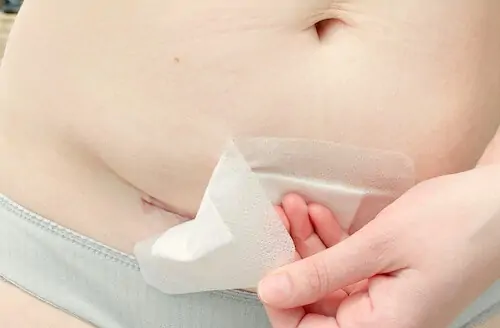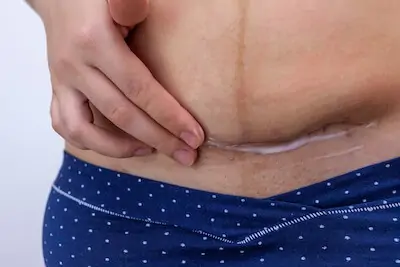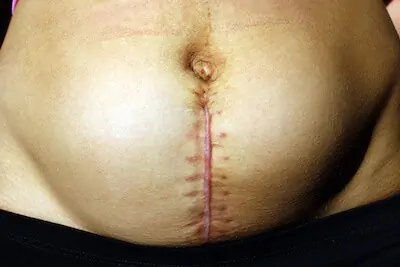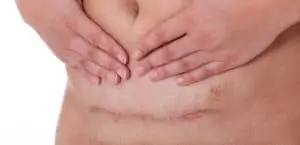I know it’s not all that long ago that I had my second c-section; it feels like it. Trying to think back, I can’t recall the c-section stitches dissolve time. My husband can’t remember either, though this is someone who can’t remember where he put his keys when holding them.
Anyway, if your c-section stitches are not dissolving, don’t worry. I’ll cover why your dissolvable stitches are not dissolving and what you can do about it.
As for me, I think mine were the dissolvable type. I do not even remotely recall having anything else removed. And while I was sore for a month, at my 6-week postpartum checkup, the doctor was pleased with my recovery and her handiwork. She earned her bragging rights…you can’t even see my scar now unless you REALLY look for it.
Do c-section stitches dissolve?
Now here’s something I didn’t know until after my first c-section. You get 2 incisions. Yup! They cut through your abdomen, and then they cut open your uterus.
As such, your doctor will need to close both of those openings.
They cut 7 layers to reach the baby. Here are those.

For the interior, dissolvable stitches are always used. Because they’re not going to slice you open again just to remove them, are they? Of course not! That would be idiotic!
A sigh of relief…
These dissolvable stitches are designed from materials your body can easily break down. It will take them time to dissolve, but they will.
But for your abdomen, it will depend on what your doctor uses. Some will use surgical staples. Others use non-dissolvable stitches that you’ll have to have removed though it does take longer, about 30 minutes after birth, to finish sewing you up. And others will use the kind that dissolves, so you won’t have to worry about a thing.
There is evidence stitches result in fewer complications, though, so it might be worth it to get stitched back up again. You’ll have both options removed a week after by visiting your doctor’s office. And no, it doesn’t hurt!
Surgical glue is another option. They apply it over the wound to create a protective covering. This gradually peels away as your wound heals up.
I recommend speaking to your doctor about c-section stitches, staples, and glue. This is especially important for those planning a c-section though some of you may have an emergency c-section you weren’t planning. It might not be a bad idea to ask how they will close you up if that happens and express your preferred choice.
How long do c-section stitches take to dissolve?
A couple of days after you give birth, your internal stitches will dissolve. Do not worry, as they don’t need to be removed. As the external stitches aren’t the dissolving type, they will be removed either on day 4 or 5 at the hospital or, if you’ve been discharged, at your doctor’s office. For dissolvable stitches, they should dissolve within a week.

As for staples, those will most likely be taken out at the hospital. And while they may look gross and scary, they will not hurt. You may feel a slight tugging sensation, but you will not feel pain.
A midwife can also help remove the external staples, even if you’ve already gone home.
Anyone who has a vaginal birth with tearing or had an episiotomy uses dissolvable stitches for that. They will dissolve within a few weeks, so you won’t need to remove them but if you have questions, ask your doctor.
As for steri-strips or glue, they should fall off on their own. If not, you can peel them up a week after your surgery, depending on your doctor’s advice. Always check first.
Regardless of what has been used to seal you back up, ask your doctor what will happen. Then you will know what to expect with what they have used on you.
When do internal stitches dissolve after a c-section?
I know it’s weird because you can’t see them but trust me, these internal stitches will dissolve. The skin will start healing in about 5 to 10 days on the outside. But those internal stitches will take longer to heal, roughly 12 weeks before you feel completely like you did before giving birth.
That’s not to say you won’t feel better before then, but the internal area needs time to heal. This is why your doctor will tell you not to get pregnant again for at least a year after your c-section. The bare minimum would be 6 months, but you’re more prone to complications if you don’t wait it out.
Internal stitches will dissolve after a few days, even if the healing takes longer. And they don’t need to be removed.
So, how do you know if anything is wrong? Keep an eye on the external incision. Get medical attention immediately if you see redness, swelling, itching, pus seeping out, or you have a fever.
When are stitches removed after birth?
Stitches are usually removed 4 to 5 days after your c-section surgery. It will not hurt, so don’t be alarmed. If you have concerns about your stitches or sutures, make sure you address them with your doctor.
And if you have dissolvable stitches on the outside, you shouldn’t have to worry at all. They will dissolve on their own after about a week. You won’t even see them if you notice signs of an infection. Get to the doctor right away.
How do you know if you need to get them removed? Your doctor should TELL you about this. But if not, or you can’t remember if they did, ask before you’re discharged. They will let you know what follow-up is required.
How are stitches removed after a c-section, and does it hurt?
It does not hurt to have your stitches removed for a c-section or anything requiring stitches, FYI. They will use sterilized surgical scissors or tweezers to pull up and remove the stitches gently. You won’t feel a thing, perhaps maybe a slight tugging, but really that’s it.

As for staples, it may pinch if embedded slightly in your skin, but it won’t hurt, I’m told by my friends who had staples.
Incidentally, you should heal up the same whether you have staples, stitches, or glue. An Italian study found there were no overall differences in the cosmetic results.
The only real difference is in skin color; women with darker skin are more likely to get the raised scars known as keloids. Additionally, women with certain medical conditions like diabetes, for example, and smokers may have a poorer way of healing than others.
Again, if you have a preference or a concern, discuss it with your doctor. Traditionally, surgeons would choose staples because it’s much faster, but many choose absorbable sutures since it means they don’t have to remove them. So that’s easier for you and the doctor.
C-section stitches not dissolving in 3 weeks; what to do now?
If you’ve received absorbable stitching externally, your c-section stitches should dissolve in a week or 2 on the exterior. You likely won’t even see them.
The dissolvable stitches should dissolve or even fall out on their own during that time. But if you see them still there at 3 weeks, call your doctor’s office.
Don’t do it as tempting as it may be to rip them up yourself. You could infect the area. Instead, call your doctor and let them know. They’ll likely have you come in so they can inspect the area and remove the stitches.
And if your c-section scar hurts years after, it’s known as incisional endometriosis. This is when tissue builds on the scar and causes painful adhesions. If you feel pain after a year, you should discuss it with your doctor to find its cause and take care of it.
Final thoughts on c-section stitches…
The best thing you can do with your c-section stitches is to find out about them. Some of you will be like me, rushed in for an emergency c-section. I sure hope not, but it does happen.
And when it does, you won’t have time to ask how they’re stitching you up. Afterward, though, ask all the questions. They will review how to take care of your c-section incision and if or when you need to come in to remove the materials.
If anything is unclear, ask! This way, you’ll know what to do no matter what!
Also, if anything ever feels weird, you notice infection signs, or anything else, don’t hesitate to inquire. So many new mamas feel like they’re asking stupid questions, but you’re not.
This stuff can be scary, and if it’s your first time doing it, you won’t know what’s normal and what isn’t. Asking questions will help you determine if what’s happening to you is following the right course or if you need to see the doctor.
Leslie Berry lives with her husband and two young daughters in Los Altos, California, where she loves helping other moms get comfortable with motherhood and embracing the insanity with facts peppered with laughs.
She loves eating too much sushi, exercising, and jamming out on her Fender. Read more about Leslie here.

